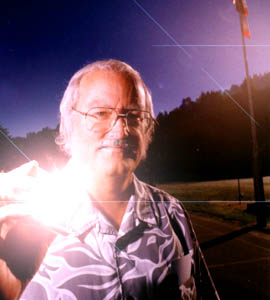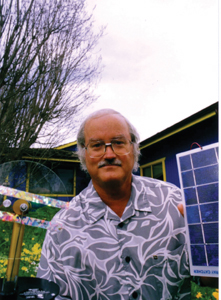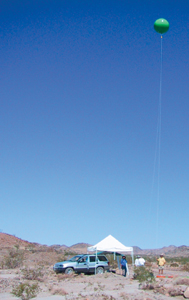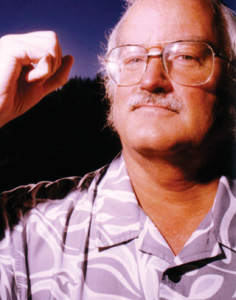![[Metroactive Features]](http://metroactive.com/features/gifs/feat468.gif)
[ Features Index | Santa Cruz | Metroactive Home | Archives ]
Remember the Titan
Forget Mars--NASA scientist Joe Jordan is already looking for life among the moons of Saturn. But don't forget to go green, or you'll hear about it from the Cabrillo instructor who is practically a one-man energy revolution for Santa Cruz.
By Mike Connor
'If I wanted to bother to wait in line to talk on Rush Limbaugh's radio show," warns NASA researcher Joe Jordan, his faded Southern drawl becoming more pronounced as his blood rises, "some of the bullshit he puts out on the ozone layer, I could just completely dash all his ... balderdash. And I'd do it in a fun and interesting way, which wins people over. Somebody needs to be doing that."
Somebody, sure, but maybe not Joe Jordan. Not just yet anyway, because this particular scientist already has a lot on his plate--literally. When I first met with him at the home of Rob and Susan D'Arcy, perched high in the hills above Rodeo Gulch, he helped himself to a gladiator's share of deliciously rich shrimp pasta. Having arrived a bit late, he cleaned his plate while the rest of the lunch guests discussed 14-year-old Jaclyn D'Arcy's hugely ambitious science project: to convert a car's regular internal combustion engine into one that burns hydrogen. Only five years ago, Jaclyn's sister Nicole gained national attention for building an ice cream maker powered by hydrogen fuel cells, a project inspired by one of Jordan's passionate complaints about the general ignorance and resistance around hydrogen and other renewable sources of energy.
Like most advocates of renewable energy, Jordan is sick of seeing all the money go toward industrial and military purposes. When he was just out of college, the young scientist went to work for a Navy think tank, which afforded him a glimpse of where all that money is going.
"I had top secret clearance with the military," says Jordan, "with all the access to the info that was supposed to scare me into believing we had to have this huge arms race. I asked some probing questions, and I never got a satisfactory answer. I concluded that there's a lot of dimwit paranoid thinking, and a lot of money to be made by defense contractors, but not really any true compelling defense reasons for what we were doing. And I no longer had to put up with people telling me, 'If only you knew what we know, then you'd know why we have to spend all this money on the military.'"
Turning Santa Cruz Green
These days, he's becoming a lightning rod for renewable energy. When he's not busy designing software for NASA and conducting astrobiological experiments in the deserts of Chile for SETI (Search for Extraterrestrial Intelligence), Joe Jordan is realizing his mission to educate as many people as he can about renewable energy.
He took a giant pay cut to get down on the front lines teaching public school for two years. When he served as Public Works Commissioner for the city of Santa Cruz, part of his master plan was to create solar infrastructure on area schools, which would be environmentally responsible and educational. He enlisted Solar Technologies to install a 1-kilowatt photovoltaic (PV) solar system on the roof of ARC Alternative High School on Swift Street. With the help of Ecology Action, he secured the grant for a 15-kilowatt system from the city of Palo Alto to install solar panels on the roof of Santa Cruz City Hall. Despite the bureaucracy involved, he'd even like to get PV going on UCSC, a project about which he remains optimistic, in light of the new green building requirements voted in by UC students.
Meanwhile, Jordan is spreading the renewable energy bug teaching classes at the Monterey Institute for International Education and at Cabrillo College, and on wilderness hikes around California.
"In my classes, I make the case that energy is arguably the most important thing that we can teach and learn about--for one thing just because everything in the material world is energy, ultimately," he says. "A particle of matter is just a little bundle of energy coiled up on itself. But also, it's by far the most polluting industry in the world."
With his wild white locks and big, squarish science-guy glasses, Joe Jordan is that fabled kind of brilliant scientist who relies on brute memory to keep a kajillion pet projects in a row. Names and dates, facts and figures and phone numbers are filed in his brain with the precision of a hurricane. But he wields the information like a sorcerer with a purpose: to do battle with whom he calls the "oil boys" and the forces of darkness and ignorance. And what better weapon for him to use than the sun?
Sun Worshipper: "The best kept secret in the world is that one hour's worth of energy coming in and hitting the land area of the United States from the sun brings in enough energy to power this whole country for a whole year," says Jordan.
Sky Power
"The best kept secret in the world is that one hour's worth of energy coming in and hitting the land area of the United States from the sun brings in enough energy to power this whole country for a whole year," says Jordan. "A circle 50 miles in radius of solar cells would provide all the electricity you'd need for the whole country. Not that you'd want to put them all in one place."
Like many champions of renewable energy, Jordan is keen on the idea of "distributed generation." It's the new wave among renewable energy advocates, both for its democratic appeal (everyone can produce their own energy, effectively granting "power to the people") and for its appeal in the wake of the Sept. 11 terrorist attacks. Whereas huge power plants and pipelines make attractive targets for terrorists, widely dispersed energy production would make sabotage much more difficult. And, as Jordan points out, it would be "home-grown."
The problem is that the "cheap and dirty" coal, natural gas and nuclear-based energy infrastructure represents hundreds of billions of dollars in sunk investments and subsidies, and you can bet the farm that, right or wrong, the individuals, corporations and even governments that put their eggs in that dirty, toxic basket still want the returns on their investments. Jordan says we need a veritable "Apollo program" of national initiative from the top. And so, as any conscientious citizen might, Jordan tried taking his concerns straight to the top dogs.
"I met Al Gore briefly down on the Seventeen Mile Drive back when Clinton was making his first presidential run," recalls Jordan. "I remember he came by and I stuck out my hand, shook his hand and said, 'Make sure you get solar energy in there!' And he turned around and he said, 'Ah will!' And we never heard anything more about it from him, hardly. In the second presidential debate with Bush, Gore said something about 'new kinds of cars and trucks that Detroit is just itchin' to build.' Pfft! What the hell does that mean? Why didn't he say hydrogen fuel cells, or renewable energy, or solar?"
Fair questions, especially in light of the brave new world of hydrogen that President Bush hailed in his 2003 State of the Union address. He's since dedicated $1.7 billion of the federal budget to the Freedom Car program and Hydrogen Fuel Initiative, but what most people don't know is that under the current plan, we'll be producing hydrogen--an energy-intensive affair--from nuclear power.
As recently as October of 2003, President Bush gave a speech in Ohio saying "Congress should promote research into the next generation of nuclear plants and encourage investment in existing nuclear plants to expand a clean and unlimited source of energy," yet he conveniently left the touchy word "nuclear" out of his 2004 State of the Union address. Naturally--it's too easy a target for both criticism and terrorism. But what's the alternative, given the current state of renewables?
"One of the standard lines that you always see, is well, you know, solar and wind and renewables are great, but they just can't possibly make a difference in time, or any time in the near future," says Jordan, "And I say, of course they can't, if you don't fund the research and development, and if you don't make it a priority, and if you keep ladling out pork and government largess on all the conventional cheap and dirty energy sources. However, if you actually do it right and just don't subsidize anybody, or make it a much more fair, even kind of subsidization, well then yeah, then renewables can make a major contribution in a hurry. And they have to."
Balloon Man: Jordan and friends doing research in the desert.
A Kerry Connection?
Hoping to find some sign of intelligent life in the government after the 2000 election, Jordan did a bit of research and dug up an article championing renewables written by a U.S. senator named John Kerry. Jordan included the article in a reader for his Cabrillo College class, and was surprised years later to find that his pet senator was running for president.
"That's something that his campaign hasn't really been pointing out," says Jordan, "and I think that just as with Gore, if they do even better than they're doing--if they would point out that hey, he's a champion of renewable energy, I think that turns people on in this country. And unfortunately, their interest is not being fed."
Now, with Bush looking to shoot some poor bastards up to Mars, many Americans are pooh-poohing the wisdom of such a costly federal endeavor. For his part, Jordan is hopeful about what we might learn from the less-expensive, unmanned probes out in space. Besides the rovers on Mars, another probe is getting close to Europa, a moon of Jupiter, in hopes of discovering microbial life there. Another probe will visit Titan, a moon of Saturn, to examine what might be an organic haze in the atmosphere.
"We think there's some kind of hydrocarbon sludge at the base of that atmosphere," says Jordan. "I tell people, maybe Bush should invade there next!"
Esoteric astronomer jokes aside, yet another probe is on its way back from its successful mission of actually sampling a freaking comet. As Jordan describes it, the probe flew near the comet and, amid tiny comet particles flying at it many times faster than a speeding bullet, a small paddle peeked out, grabbed some comet chunks and ducked back into the probe. Stardust, anyone?
"Part of humankind's birthright is our curiosity, and our quest for knowledge about our home here in the universe, not only of this planet but beyond," muses Jordan, "and it would just be a tragedy to forfeit that because we say, 'Well, we gotta solve all our problems first and then we can go out to space.' That's just ridiculous--you gotta do both."
"I talk to people who I really have a lot of respect for, they just couldn't care the least that we've got a spacecraft going to Titan and a couple rovers on Mars, because we've got too many problems on the Earth!" he continues. "Well, I'm extremely concerned about problems on the Earth and I think I've got some damn good ideas of what to do about them. Back in the days of the Vietnam War, in the heyday of the Apollo program, the argument I always got was, 24 billion dollars for moon rocks? And I pointed out, hey, that's a wonderful expense of government money, and it's not just for moon rocks. There are all these spin-offs of the space program: computers and management techniques, systems analysis and medical developments ... sometimes you need a really good project and things come out of it in ways that you can't really predict or legislate or plan."
While he recognizes the potential and importance of research and development in the private sector, Jordan ultimately favors a government-coordinated effort, using history as an example of what government-sponsored programs enable.
"Witness Microsoft and how they've screwed up all kinds of things in the computer industry trying to keep everything to themselves and make everyone else do things with their stuff," says Jordan. "You'll have companies that can do this stuff, but no company could have mounted an Apollo program or a Manhattan Project; that had to be government funding."
True enough--as far as hydrogen goes, NASA uses it as propulsion fuel in booster engines, and astronauts have been drinking the refreshing byproduct (pure H20) of their hydrogen-powered on-board electrical systems for years. But even without government funding, heartening developments are at hand. Gov. Schwarzenegger's plans for a "hydrogen highway" might actually pan out with the help of automakers that are already developing hydrogen-powered cars. Existing vehicles like the "Green Hummer" are capable of running on hydrogen, compressed natural gas, biodiesel and straight vegetable oil or regular diesel gasoline, and can be yours for a mere $159,000. Wave and tidal power are on the cusp of major-league viability, as is geothermal power. And to top it all off, Iceland is on its way to becoming the world's first hydrogen economy. Not surprisingly, Jordan is going to check it out for himself in a couple weeks when he leads a stargazing trip to see the northern lights in the sky above the little Nordic island.
Stargazer
It won't be his first time seeing the Aurora Borealis. Jordan spent 10 years studying ozone depletion in the polar stratosphere in one of his first gigs for NASA. The project opened his eyes to the damaging effects of the chloroflorocarbons, methal bromides and halons that pollute the atmosphere, but it also enabled him to see the northern lights from a remarkable perspective--in an airplane flying directly above the North Pole.
"The North Star was straight overhead, and through a window above the pilot's seat in the cockpit I could see it being speared by our orange and green laser beams that were firing toward the zenith point many times a second, probing the atmospheric aerosols above us. Later in that flight, I asked one of the pilots if he'd seen any auroras (northern lights) yet, and right at that moment one appeared or became noticeable off to the left, growing as we flew on until it became a vast bluish-white glacier of light on both sides of the plane and all the way across the top of the sky, trailing off to bright green ribbons toward the horizons."
Adding to his high-flying résumé a few years ago, Jordan worked on a NASA project studying jet contrails, which some scientists believe exacerbate global warming when they spread out into cloud decks that last for hours.
"We actually did flights right in contrails," says Jordan, "in a fully instrumented DC-8 a mere three miles (20 seconds) behind a 757 with low-sulfur fuel in one wing and regular fuel in the other; and the whole plane was rocking and rolling like 40 degrees, with people getting sick in the back of the plane but still dutifully taking data on their computers. It was wild airborne science! I was in the cockpit some of the time, and the contrails were spectacular blazing white spirals that we were flying down the vortex of, like in some video game, set against the beautiful electric-blue sky. Sometimes it was like a series of giant bright donuts coming at us, one after the other."
Jordan dismisses the idea of "chem-trails" with a chuckle, saying that the clouds on one of the chem-trail websites are just regular jet contrails and cirrostratus clouds. "Unfortunately," Jordan says of the chem-train believers, "they just don't know much about science."
In Demand: The always-multitasking Jordan will be discussing solar power for the Museum of Natural History April 1, and leading a stargazing evening at UCSC on April 21.
Looking Sideways at Scientists
Jordan, on the other hand, knows a ton about science, thanks in part to his boyish fascination with natural phenomena. The story goes that when he was 3 years old, he was at his grandma's house for dinner back in North Carolina when his family suddenly noticed he wasn't at the table. They found him about a half mile down the old country road, staring at the moon.
He went on to earn a B.A. in physics at Oberlin College and an M.S. in computer and information sciences at UCSC, and then to work for Sterling Software doing computer modeling work for the NASA Ames Research Center, where he still works.
Colleagues and friends alike gush about his ability to share scientific information in a way that's nothing short of a spectacle, a talent that he exploits regularly as a teacher, public speaker and eccentric trail guide.
During his "Physics in Nature" walks he leads right here in Big Basin State Park and as far away as Sequoia National Park, Jordan is full of everyday physics facts and demonstrations. Just after lunch at the D'Arcy residence, Jordan brought us all outside on the porch to show us how to look at sun spots with binoculars by using them to project the sun's image safely onto a flat surface, where they become visible. It's like hanging out with Mr. Wizard; his enthusiasm is infectious.
"I think that's probably my main 'gift,' or whatever--making sort of complicated things understandable to the general public, and interesting and fun, with sort of a storytelling approach to science," says Jordan. "I used to do a radio show in Oberlin called Looking Sideways at Science, and what it means is, well, if you look sideways at a big view, it's amazing how it changes it, much more than just rotating it 90 degrees. It makes the foreground really stand out, and the background becomes like a two-dimensional painted mural. And, for instance, twilight colors in the sky after the sun has gone down, they stand out in ways you just never noticed. And then you look back up and you say, 'Oh yeah, there's that faint band of green, I never noticed it before.'"
With his head tilted thus, Jordan's perceptions of earthly phenomena are somewhat skewed--in a revelatory direction. A sunset at a right angle reads like a book, the story beginning on the left in the deepest mysteries of space, flowing across a grand continuum from the infinite to the here-and-now, where answers stare us in the face.
"Look around us right here, all the greenery," says Jordan, motioning to the lush hillsides as we stroll through the Rodeo Gulch. "The world evolved green, and that's a testament to the huge power of the sun. The plants are green because they're tuned with chlorophyll to harvest this solar energy ... I mean it's in the cards in nature, we just need to figure out how to do it most economically and conveniently. Where there's a will, there's a way. But the problem right now is that the will's not there, and part of that is that the knowledge is not there. The oil boy network is doing a good job of keeping it under wraps. And I mean I'm not a conspiracy theorist or anything, it's just that it's not a priority of the oil boy network, and we need to make it a priority ... starting with this fall's election."
[ Santa Cruz | Metroactive Central | Archives ]
Copyright © Metro Publishing Inc. Maintained by Boulevards New Media.
For more information about Santa Cruz, visit santacruz.com.
![]()

The Lizard King: UCSC professor of biology Barry Sinervo will discuss 'Sex in Lizard Land' on Feb. 4.

Photo by Adam Wright

Photo by Chris McKay, NASA/Ames

Photo by Adam Wright
Joe Jordan will lecture on solar energy at the Santa Cruz City Museum of Natural History on April 1 at 7pm. For location information, call 831.420.6115. To learn more about Joe Jordan's projects, visit www.sky-power.org. For information about how you can get involved with environmental causes, visit Ecology Action's website at www.ecoact.org.
From the February 18-25, 2004 issue of Metro Santa Cruz.